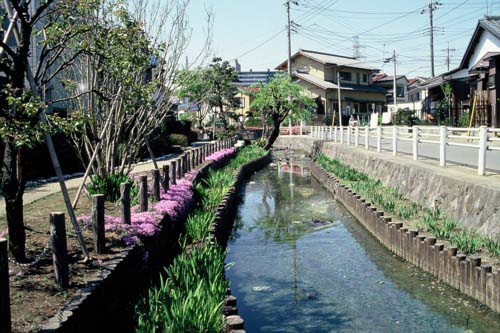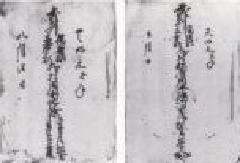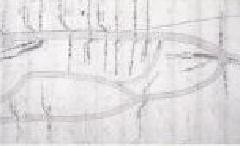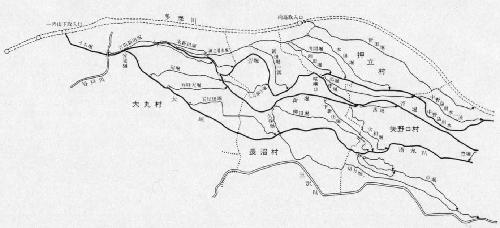Last updated: June 28, 2017

Sugebori of Daimaru canal (near Higashi Naganuma)
Omaru Yousui is a water source that draws water from the Tama River in Daimaru, Inagi City and flows to Noborito, Kawasaki City. It's been done. Although there are no clear historical records regarding the timing of excavation of water for irrigation, it was a large-scale flood control and water utilization policy aimed at increasing the income of the annual tribute of the Edo Shogunate. It is thought to have been built around the 17th century as part of the In the surrounding area, excavation work was carried out for the Nikaryō irrigation canal and the Fuchu irrigation canal at the beginning of the Edo period. I understand. Also, according to the Komonjo (Kawasaki City, Sabota Family Documents) dated 1746 (Enkyo 3), since 1699 (Genroku 12), repair materials have been used by the Daimaru Canal Union. Since it is written that the burden was carried out, there is no doubt that its establishment goes back at least to the 17th century.
The outline of the water flow path is as follows. The intake was at Daimaru's "Ichino Yamashita" (slightly upstream of the current Nambu Line Tamagawa iron bridge). An intake weir with a length of about 100 ken (about 182 meters) was built on the Tama River, and the water of the Tama River that was dammed here was a irrigation gutter with a width of 2 ken (about 3.6 meters). (Irihi) It was taken in from (the gutter of the water gate for drawing in water). The water that is taken in first passes through the inner moat and heads to the trough. The water volume gutter is a gutter attached to separate the water for Daimaru Village from the water for other villages, and the moat width is 1 for Daimaru Village and 2 for other villages. was divided into The irrigation water for Daimaru Village that is diverted here is called Obori. After irrigating the southern part of Daimaru Village, it flows through Naganuma Village and Yanokuchi Village, and then heads for Kawasaki. On the other hand, irrigation water for other villages is divided into Sugebori and Shinbori in the eastern part of Daimaru Village. Shinbori flows across the central part of Naganuma Village, while Sugabori flows around the northern part of the village, and then heads for Oshidate Village, and is further diverted into three waterways at a diversion gate called Kenkaguchi. divided into two streams. The irrigation water, which was divided into several streams in this way, was further divided into a network to irrigate the rice paddies of villages in the Kawasaki area downstream from the direction of Yanoguchi.
During the Edo period, the areas that used the Daimaru canal were four villages in the Inagi city area (Daimaru village, Naganuma village, Oshidate village, Yanoguchi village) and five villages in the Kawasaki city area (Suge village, Nakanoshima). The villages were Sugao Village, Gotanda Village, and Noborito Village). Although these villages spanned two districts, Tachibana District and Tama District, and had different ruling lords, they all agreed to use the Daimaru Irrigation Water, and formed the "Daimaru Irrigation Nine Villages Association." I was organizing. The most important job of this water association is the maintenance and management of irrigation water, which involves repairing the irrigation moat itself and repairing facilities such as irrigation weirs and gutter. Each village paid for the materials used for the fushin. In addition, water disputes frequently occurred over the use of water. The content of water disputes varies, including over the distribution of water during summer droughts and over the construction of irrigation weirs on the Tama River, and villages have filed lawsuits with the shogunate in each case. I asked for a ruling.

Old document on water repair (Ashikawa family document)

Old documents about water disputes (Saboda family documents)
Daimaru irrigation water, which has been maintained and managed since the Edo period, is gradually losing its function as agricultural water in modern times. Current management is carried out by the Daimaru Irrigation Land Improvement District, which was established in August 1952, but the area of cultivated land that uses irrigation water has been decreasing year by year. The current situation is that Due to the decline in paddy fields, water that is no longer needed is reclaimed, and the situation has changed, but recently it has been developed as a new water park, and continues to exist as a valuable waterfront.
Daimaru Canal Channel Map (created from Inagi City History Volume)
Ancient documents of water disputes (Sahota family documents)
Ancient documents on water repair (Ashikawa family documents)

Daimaru irrigation waterway map (created from Inagi city historical volume)
Inagi City Education Department Lifelong Learning Division Tel: 042-377-2121